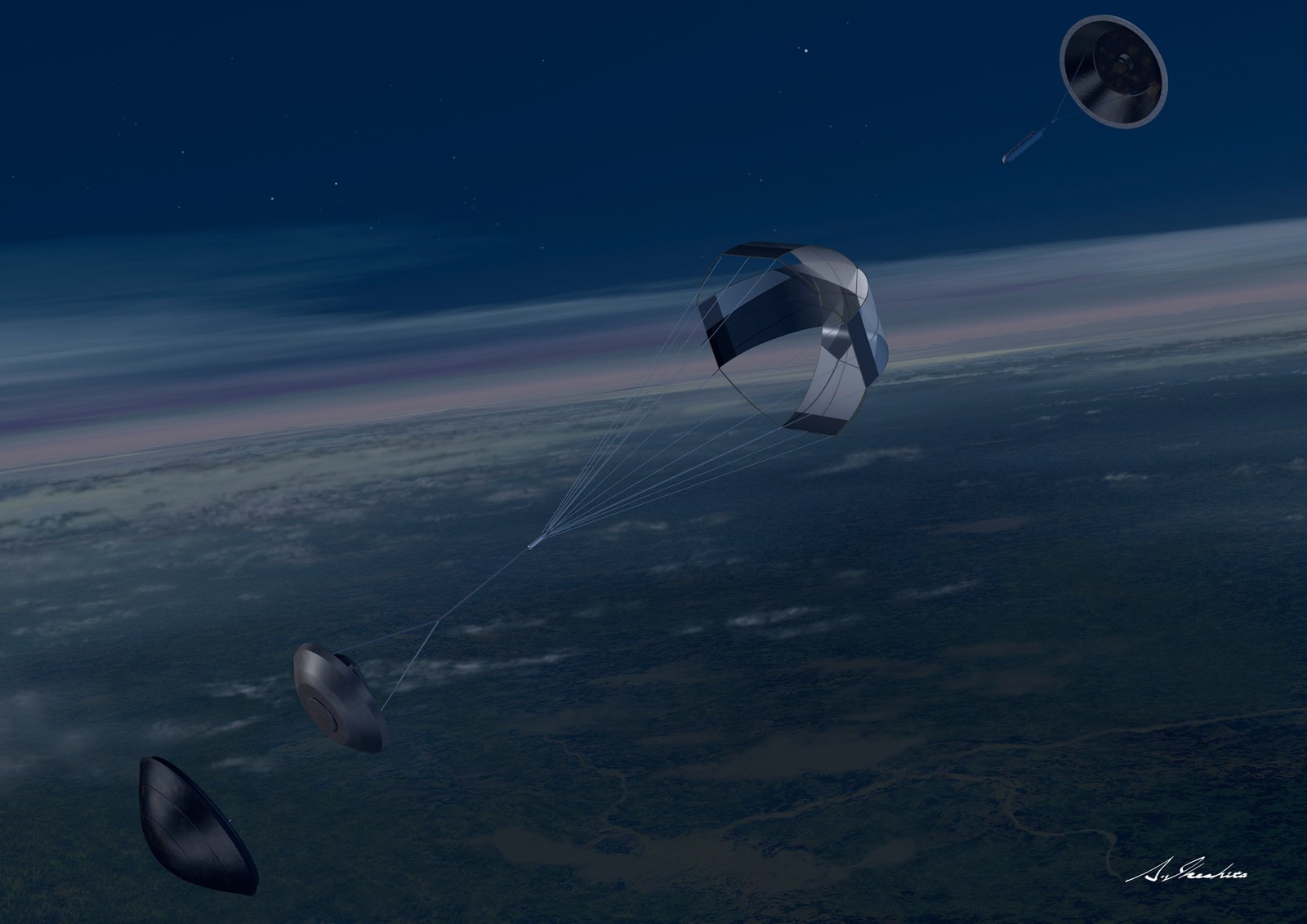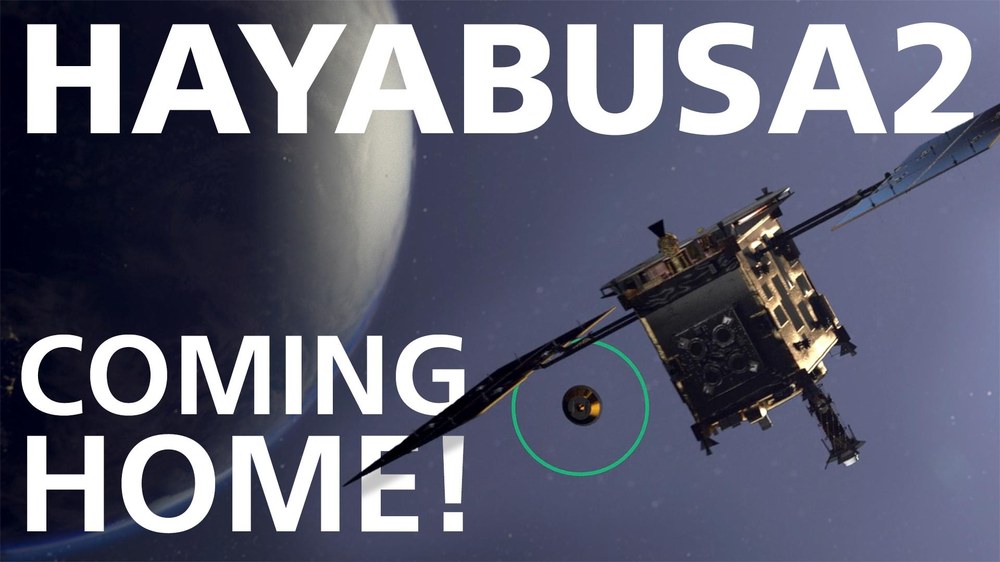Capsule with asteroid samples scheduled to land in Australia this weekend

- +++ Update: The Hayabusa2 sample capsule successfully landed at the Woomera Test Range in Australia. JAXA was able to locate the capsule by helicopter on 5 December 2020 at 20:47 CET, and subsequently recovered it. Further information can be found on the JAXA website. +++
- First analysis of the samples from Ryugu, an asteroid that crosses Earth’s orbit.
- Hayabusa2 is one of the most complex missions in space history and will continue its journey to visit another near-Earth asteroid.
- The events surrounding the landing can be followed at a press conference on 4 December at 08:00 CET, in a livestream for the separation of the landing capsuleon 5 December at 05:30 CET, a livestream for the landing on 5 December at 18:00 CET and at a post-landing press conference on 6 December at 08:30 CET. These are all provided by the Japanese space agency, JAXA.
- DLR will report on social media using the hashtag #AsteroidLanding.
- Focus: Space, exploration, asteroids
In the evening of 5 December 2020 (CET), for the first time ever, samples from an asteroid that crosses Earth’s orbit are expected to arrive on Earth. In February and July 2019, the Japanese space agency (Japan Aerospace Exploration Agency; JAXA) Hayabusa2 spacecraft collected material from the asteroid Ryugu in two extraordinary touchdown manoeuvres; these are 4.5-billion-year-old fragments from the earliest stages of the formation of the Solar System. Now, safely stowed in a landing capsule, Hayabusa2 will eject these samples as it flies past Earth after travelling a total of 5.25 billion kilometres since it launched. The landing site is located near Woomera in South Australia. As part of the Hayabusa2 mission, the German-French MASCOT lander explored the surface of Ryugu in October 2018 and revealed a fragile cosmic ‘rubble pile’ with a lot of debris and rocks, but almost no dust. After releasing the sample capsule, the Hayabusa2 spacecraft will continue its scientific journey, steering itself towards another near-Earth asteroid that it is expected to reach in 2031. The German Aerospace Center (Deutsches Zentrum für Luft- und Raumfahrt; DLR) is expected to be involved in the analysis of the Ryugu samples from 2022 onwards.
“This is a historic moment for space exploration. I wish JAXA the best of luck with this extraordinary landing manoeuvre,” says Anke Kaysser-Pyzalla, Chair of the DLR Executive Board. “JAXA has long been one of DLR’s most important international partners. This has never been more evident than in October 2018, when the MASCOT lander, developed by DLR and our French colleagues from the French space agency (Centre National d'Etudes Spatiales; CNES), landed on the asteroid Ryugu as part of JAXA’s Hayabusa2 mission. I am sure that the analysis of Ryugu’s samples will open another insightful chapter in international asteroid research.”

Hayabusa2 – Coming Home!
Your consent to the storage of data ('cookies') is required for the playback of this video on Youtube.com. You can view and change your current data storage settings at any time under privacy.
Coming back to Earth
The separation of the landing capsule from the Hayabusa2 spacecraft will take place on 5 December 2020 at 06:30 CET, at a distance of approximately 220,000 kilometres from Earth – slightly more than half the distance between Earth and the Moon. Shortly afterwards, between 07:30 and 10:00 CET, the spacecraft will carry out another manoeuvre to depart from its collision course with Earth and move onto a departure trajectory. As soon as the sample capsule, rotating slowly around its axis, enters Earth’s atmosphere at a speed of twelve kilometres per second and an altitude of 120 kilometres, it will be slowed down by the atmosphere. Seven to eleven kilometres above Australia, between 18:30 and 18:33, a parachute that is ‘visible’ to radar will be deployed then the heat shield in front will be ejected. The 40-centimetre capsule will land at the Woomera Test Range between 18:47 and 18:57 CET. During the parachute flight, signals will already be transmitted to help a recovery team locate the 16-kilogram capsule. The team will then fly over the landing area in a helicopter to find the capsule using the locating signals and recover it in a complex procedure. In Australia, at this time, it will already be early morning, around sunrise.
Out of the desert and into the laboratory
Having been recovered from the Australian desert, the capsule will first be examined to determine its condition. The samples will then be transported by plane in the still-sealed landing capsule to Japan, where they will be transferred from Tokyo-Haneda airport to a laboratory at JAXA’s Institute of Space and Astronautical Science (ISAS) research institute in Sagamihara near Tokyo. There, according to a plan developed over several years, a mechanism will be attached to the capsule, without which the capsule cannot be opened. The capsule will be opened robotically in a cleanroom laboratory in a vacuum chamber, where the asteroid samples will be transferred into special sample containers. Initially, the individual components of the asteroid samples brought back to Earth will be curated and described. Then from mid-2021, microscopic, mineralogical and geochemical investigations can be carried out. The DLR Institute of Planetary Research in Berlin-Adlershof is currently creating facilities for some of these investigations with a new laboratory focusing on spectroscopic analyses; the institute plans to be involved in the examination of samples from 2022 onwards.
Relic from the early stages of Solar System formation
The asteroid Ryugu, just under one kilometre in diameter, is a ‘Near-Earth Object’ (NEO) – that is, an asteroid or comet that comes close to, or intersects, Earth’s orbit. However, Ryugu never comes into the immediate vicinity of the Earth and therefore poses no danger. Previous results have shown that Ryugu, as a link in planetary formation, is a relic from the early stages of the Solar System around 4.5-billion-years-ago. The carbon-rich C-type asteroid is almost entirely made of highly porous material and was most likely formed largely from fragments of a parent body shattered by impacts. The high porosity and the associated low internal cohesion of the rock fragments mean that such bodies probably break up into numerous pieces upon entering the Earth's atmosphere. For this reason, meteorites of this class of carbon-rich asteroids can only very rarely be found and analysed on Earth, because the atmosphere tends to offer us greater protection against them than it does against other asteroids. This is precisely why the examination of the Ryugu samples on Earth is of particular scientific significance. Researchers hope that the investigations will provide important indications of how asteroids of this type – for which little is known about their properties and composition – could be redirected in future in the event of an impending collision.

“To have samples from a 4.5-billion-year-old asteroid on Earth at the end of this very unusual mission, and to perhaps even be able to examine them in our DLR laboratories, is a highlight for all of us in our lives as researchers,” says Heike Rauer, Head of the DLR Institute of Planetary Research, expressing her enthusiasm for the imminent arrival of the Ryugu samples on Earth. “It is remarkable what we can discover about Solar System bodies using spacecraft and landers, but it makes a huge difference when we have samples here on Earth and can examine them in many laboratories, and it will also make a huge difference in a few decades’ time, when analysis will be much more advanced.”
Hayabusa2 will continue its journey towards a fast-spinning asteroid
During the time of Hayabusa2's flyby past Earth, approximately half of the propellant – the noble gas xenon – will still be available for its ion engines. Therefore, Hayabusa2 can continue to orbit the Sun and will visit another asteroid, the extremely fast-spinning near-Earth asteroid 1998 KY26, which is less than 40 metres in diameter. An object with these properties has never been visited by a spacecraft before. Researchers expect that these comparative observations will deepen the knowledge already gained from the Hayabusa2 mission. The spacecraft is expected to reach its second target by 2031, after two further Earth flybys to adjust its orbit
Hayabusa2 launched from Japan's Tanegashima Space Center on 3 December 2014 and reached the asteroid Ryugu in summer 2018. On 3 October 2018,the German-French MASCOT lander explored Ryugu's surface with three hops in three asteroid days. Using two touchdown manoeuvres, the parent spacecraft then collected samples that will now land on Earth. The previous mission – Hayabusa – brought back 1500 particles of the asteroid Itokawa back to Earth in 2010.
About the Hayabusa2 mission and MASCOT
Hayabusa2 is a Japanese space agency (Japan Aerospace Exploration Agency; JAXA) mission to the near-Earth asteroid Ryugu. The German-French MASCOT lander on board Hayabusa2 was developed by the German Aerospace Center (Deutsches Zentrum für Luft- und Raumfahrt; DLR) and built in close cooperation with the French space agency CNES (Centre National d'Etudes Spatiales). DLR, the Institut d’Astrophysique Spatiale and the Technical University of Braunschweig have contributed the scientific experiments on board MASCOT. The MASCOT lander and its experiments were operated and controlled by DLR with support from CNES and in constant interaction with the Hayabusa2 team at JAXA.
Related Links
Related News
- The Hayabusa2 mission – Investigating a near-Earth asteroid
- Asteroid Ryugu likely link in planetary formation
- The near-Earth asteroid Ryugu – A fragile cosmic 'rubble pile'
- MASCOT confirms what scientists have long suspected
- Numerous boulders, many rocks, no dust: MASCOT's zigzag course across the asteroid Ryugu
- Three hops in three asteroid days – MASCOT successfully completes the exploration of the surface of asteroid Ryugu
- MASCOT's asteroid landing – The preparations, the risks and the last-minute decisions
- On the trail of a near-Earth asteroid – The Hayabusa2 spacecraft and MASCOT lander reach Ryugu



